Among the Luo Near Kisumu
Domenic Cusmano
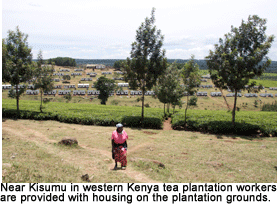 The city of Kisumu, the heart of the Luo ethnic group, lies on the eastern shore of Lake Victoria, about 300 kilometers northwest of Nairobi. Its relative proximity to the capital and to the Ugandan and Tanzanian borders, and the fact that it is surrounded by water, might suggest that Kisumu’s half-million people enjoy a relatively high standard of economic and social development. Instead, the region is fraught with severe poverty, non-existent infrastructure and the scourge of AIDS. (The Luo is also the tribe from which United States President Barack Obama traces his ancestry.) The Consolata missionaries working and living in there midst have their work cut out for them, as they try to bring hope to some of the most vulnerable people in Kenya.
The city of Kisumu, the heart of the Luo ethnic group, lies on the eastern shore of Lake Victoria, about 300 kilometers northwest of Nairobi. Its relative proximity to the capital and to the Ugandan and Tanzanian borders, and the fact that it is surrounded by water, might suggest that Kisumu’s half-million people enjoy a relatively high standard of economic and social development. Instead, the region is fraught with severe poverty, non-existent infrastructure and the scourge of AIDS. (The Luo is also the tribe from which United States President Barack Obama traces his ancestry.) The Consolata missionaries working and living in there midst have their work cut out for them, as they try to bring hope to some of the most vulnerable people in Kenya.
Roads not for the Faint of Heart
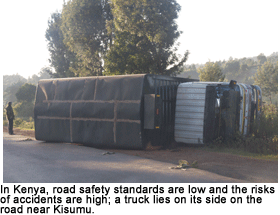 On the road from Nairobi with Father Anthony Ichuloi Oure, IMC, at the wheel, our destination is the Consolata Mission in Buoye outside Kisumu. The road is relatively smooth and safe to the halfway point – them mid-size city of Nakuru, lying on the edge of the Rift Valley. But beyond Nakuru, the road markings on the shoulders and median vanish, and the potholes become so big they could swallow zebras. What should be a leisurely three-hour drive becomes a six-hour odyssey that tests drivers’ skills and passengers’ nerves.
On the road from Nairobi with Father Anthony Ichuloi Oure, IMC, at the wheel, our destination is the Consolata Mission in Buoye outside Kisumu. The road is relatively smooth and safe to the halfway point – them mid-size city of Nakuru, lying on the edge of the Rift Valley. But beyond Nakuru, the road markings on the shoulders and median vanish, and the potholes become so big they could swallow zebras. What should be a leisurely three-hour drive becomes a six-hour odyssey that tests drivers’ skills and passengers’ nerves.
In Kenya in general and in this area in particular, road safety standards are low, and the degree of risk that drivers are willing to tolerate (or must face) are quite high compared to drivers in North America. Large swaths of “highway” are unpaved, forcing drivers to slow down or risk damaging their vehicle. An option is to swerve around the rough patches, slalom-style, and risk crashing into oncoming traffic or hitting a pedestrian walking on the shoulder (people walking along the shoulder of the highway is commonplace all over Kenya). More than once I braced myself for an impact, which fortunately never materialized. Father Anthony has travelled this road many times,
and his knowledge of the roads and his calm disposition were certainly appreciated Under such conditions.
As we get closer to inhabited areas, the roadside is increasingly sprinkled with sugar, tea and rice plantations. With such agricultural wealth, it is hard to imagine that the area is also one of the country’s least developed, according to official statistics and as evidenced by the condition of the roadway and the dilapidated structures lining either flank.
Cracks in the Buildings
We arrive at the Consolata Centre outside Kisumu just in time for lunch. We are welcomed by Father Joseph Gitonga, a Luo, and Deacon Tamene Asaro, originally from Ethiopia, who will be ordained a Consolata priest in 2012. The Consolata Centre houses a church, a number of brick buildings used as schoolhouses and a dispensary.
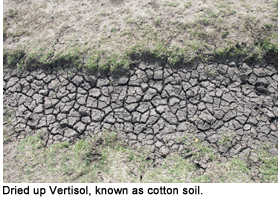 All the buildings are made of brick and appear to be quite solid. However, upon closer inspection, numerous wide cracks are easily visible in some of the older buildings, including the priests’ house. The reason is that the structures were erected on Vertisol, or what is euphemistically known as cotton soil, a fine, black type of soil with a high concentration of expansive clay that becomes very hard when dry and very sticky when wet. Because of this, cotton soil churns – shrinking and swelling easily, causing extensive damage to roads and buildings.
All the buildings are made of brick and appear to be quite solid. However, upon closer inspection, numerous wide cracks are easily visible in some of the older buildings, including the priests’ house. The reason is that the structures were erected on Vertisol, or what is euphemistically known as cotton soil, a fine, black type of soil with a high concentration of expansive clay that becomes very hard when dry and very sticky when wet. Because of this, cotton soil churns – shrinking and swelling easily, causing extensive damage to roads and buildings.
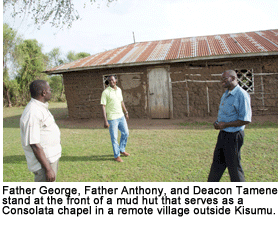 As Deacon Asaro explained, it is a serious and expensive problem that the Consolata Missionaries in Kisumu must resolve very soon – to shore up the older buildings or tear them down and rebuild them to a more stringent building code before they crumble altogether. Either way, it will cost a lot of money. Meanwhile, plans are moving forward with the construction of a new school in a nearby area, where strangely enough, the soil is completely different and amenable to brick and mortar construction. The digging of the foundation of Buoye Primary School has already begun.
As Deacon Asaro explained, it is a serious and expensive problem that the Consolata Missionaries in Kisumu must resolve very soon – to shore up the older buildings or tear them down and rebuild them to a more stringent building code before they crumble altogether. Either way, it will cost a lot of money. Meanwhile, plans are moving forward with the construction of a new school in a nearby area, where strangely enough, the soil is completely different and amenable to brick and mortar construction. The digging of the foundation of Buoye Primary School has already begun.
Mud Hut Village
A few minutes’ drive from the Consolata Centre, near the town of Ahero about 20 kilometres east of Kisumu, is an enclave of mud huts, where the problem of cracks in the walls is not an issue! Onong’no Primary School is also made of mud, and it is not sufficiently large to accommodate all the students. Today, as on most days, classes are being held outside. Under the shade of a cluster of trees, a group of pre-teen boys and girls are roleplaying as they practice their English under the watchful eye and attentive ear of their teacher.
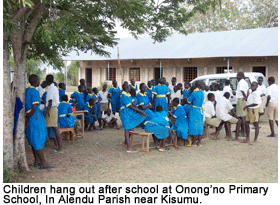 The benches are few and rudimentary, and most children stand or sit on the ground for lack of seating. An inscription on one of the benches, used by each group as it takes turns to rehearse the prescribed lines, reads: “Donated by Ahero Town Council.”
The benches are few and rudimentary, and most children stand or sit on the ground for lack of seating. An inscription on one of the benches, used by each group as it takes turns to rehearse the prescribed lines, reads: “Donated by Ahero Town Council.”
The staff accommodations are less than primitive. Teachers prepare classes in a two-room mud hut with earthen floors. Posters and other papers are pinned to the walls. A large hand-written poster hanging over the doorway leading to the back room lists the school aims, mission and motto, the latter of which reads: “Hard work pays.” The teachers and administrators are eager to show me the subhuman conditions under which they must live and work.
The contrast between the neat tea and sugar plantations a few minutes’ drive from here, and the abject conditions under which these teachers teach and their students learn is puzzling. One wonders how human beings can tolerate such miserable conditions – poor roads, no electricity, no sewage system, no garbage collection, and no running water. On the other hand, perhaps there is already much to be thankful for in the fact that this school exists at all, and that many children attend, instead of being abandoned to themselves in the street – a plight that afflicts many poor Kenyan children.
The role-playing lesson over, the girls gather together and laugh loudly about something that could only matter to them. As they go off, the boys join in a soccer game that is already underway in an empty field nearby. I have no doubt, judging from the intensity of the play, that something important is at stake – as it is in all the soccer matches I have ever watched (and played), especially those involving children, mine included.
